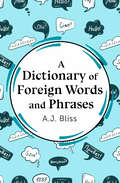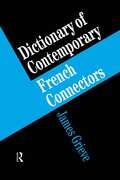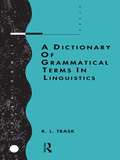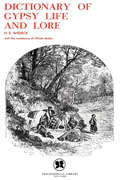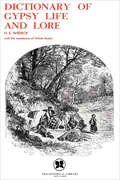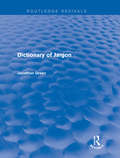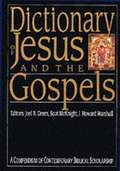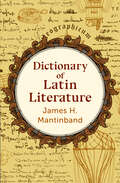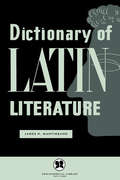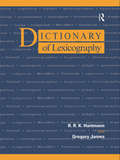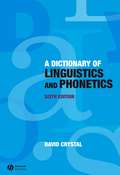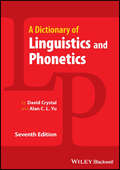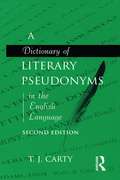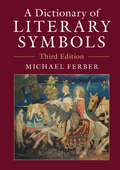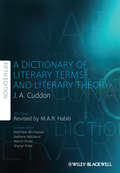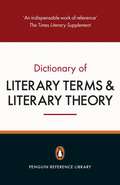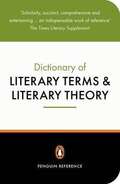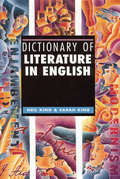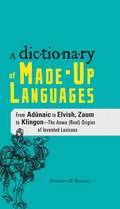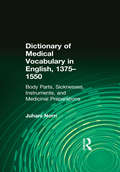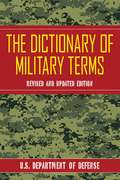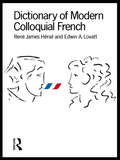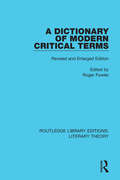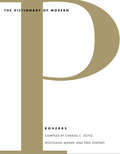- Table View
- List View
A Dictionary of Foreign Words and Phrases
by A J BlissA fascinating A-to-Z reference to foreign words and phrases that have become part of contemporary English usage. The English language has been greatly enriched by a vast array of words and phrases imported from other tongues, such as comrade, chateau, wunderkind, and vox populi. For the average English speaker, many are bound to be familiar. Some may even appear to be standard English, while others may seem, well,foreign. A Dictionary of Foreign Words and Phrases presents a comprehensive list of such terms, with entries that reveal their meanings and etymologies.
A Dictionary of French Connectors
by James GrieveConnecting words and phrases are essential for discussion, clarity and fluency in any language. French is particularly reliant on connecting language: also and in fact have around 15 equivalent words and expressions in French. This is the first French-English dictionary to focus on this fascinating and crucial part of the language. The dictionary presents nearly 200 full entries in alphabetical order, including: de plus; et ce; or; c'est dire que; en fait; au total; voila. Entries define, discuss and exemplify the whole range of connecting language in French. 2000 examples add further clarity and are chosen from a wide range of registers and mainly contemporary prose.
A Dictionary of Grammatical Terms in Linguistics
by R.L. TraskThis dictionary of grammatical terms covers both current and traditional terminology in syntax and morphology. It includes descriptive terms, the major theoretical concepts of the most influential grammatical frameworks, and the chief terms from mathematical and computational linguistics. It contains over 1500 entries, providing definitions and examples, pronunciations, the earliest sources of terms and suggestions for further reading, and recommendations about competing and conflicting usages. The book focuses on non-theory-boumd descriptive terms, which are likely to remain current for some years.Aimed at students and teachers of linguistics, it allows a reader puzzled by a grammatical term to look it up and locate further reading with ease.
Dictionary of Gypsy Life and Lore
by Wade Baskin Harry E WedeckThrough the centuries, Gypsies all over the world have been misunderstood, maligned, rejected. Outcasts of the countries in which they live, they have wandered for centuries over the face of the earth. They have no homeland, no political unity, no recognition among nations. They have been alone, sundered, shunned, persecuted and banished. Until about a century ago, their original home had been a matter of dispute. Their language had been a source of puzzlement. Yet their conduct and their traditions, their feeling for music, dance and song, have all been acclaimed. Still they were not accepted and were forced to remain apart from conventional society. Here is their epic history, with its folktales and beliefs, its rites and customs. Here is the vast treasury of the Gypsies.
Dictionary of Gypsy Life and Lore
by Harry E. Wedeck Wade BaskinThis comprehensive reference volume offers in-depth information on one of the world&’s most fascinating and misunderstood cultures. Throughout history, Gypsies all over the world have been maligned and rejected. Outcasts of the countries in which they live, these nomads have wandered for years over the face of the earth. They have no homeland, no political unity, no recognition among nations. In popular folklore, they are vagrants, thieves, tinkerers, and con artists, which is to say, egregiously misunderstood. Until about a century ago, these travelers&’ original home had been a matter of dispute. Their language had been a source of puzzlement. Yet their conduct and their traditions, their feeling for music, dance and song, have all been acclaimed. Harry Wedeck&’s Dictionary of Gypsy Life and Lore sheds much-needed light on the true history and culture of the Gypsies, separating fact from fiction while celebrating their folktales, rites, and customs.
Dictionary of Jargon: A Dictionary Of Jargon (Routledge Revivals)
by Jonathon GreenFirst published in 1987, the Dictionary of Jargon expands on its predecessor Newspeak (Routledge Revivals, 2014) as an authoritative reference guide to specialist occupational slang, or jargon. Containing around 21, 000 entries, the dictionary encompasses a truly eclectic range of fields and includes extensive coverage of both British and U.S. jargon. Areas dealt with range from marketing to medicine, from advertising to artificial intelligence and from skiing to sociology. This is a fascinating resource for students of lexicography and professional lexicographers, as well as the general inquisitive reader.
Dictionary of Jesus and the Gospels: A Compendium of Contemporary Biblical Scholarship
by Joel B. Green Scot Mcknight I. Howard MarshallRecipient of a Christianity Today1993 Critics Choice Award! Third Place Winner of Christianity Today's Book of the Year list award! The Dictionary of Jesus and the Gospels is unique among reference books on the Bible, the first volume of its kind since James Hastings published his Dictionary of Christ and the Gospels in 1909. In the more than eight decades since Hastings our understanding of Jesus, the Evangelists and their world has grown remarkably. New interpretive methods have illumined the text, the ever-changing profile of modern culture has put new questions to the Gospels, and our understanding of the Judaism of Jesus' day has advanced in ways that could not have been predicted in Hasting's day. But for many readers of the Gospels the new outlook on the Gospels remains hidden within technical journals and academic monographs. The Dictionary of Jesus and the Gospels bridges the gap between scholars and those pastors, teachers, students and lay people desiring in-depth treatment of select topics in an accessible and summary format. The topics range from cross-sectional themes (such as faith, law, Sabbath) to methods of interpretation (such as form criticism, redaction criticism, and death of Jesus) to each of the four Gospels as a whole. Some articles--such as the Dead Sea Scrolls, rabbinic traditions and revolutionary movements at the time of Jesus--provide significant background information to the Gospels.
Dictionary of Latin Literature
by James H MantinbandDiscover the essential works of Latin literary masters with this A-to-Z reference guide spanning from ancient Rome to the Renaissance. In Dictionary of Latin Literature, classics scholar and translator James H. Mantinband provides students and curious readers with an authoritative, accessible, and wide-ranging reference book. It includes detailed entries on significant works and authors as well as important terms and concepts. Covering the history of Latin literature from the early Roman Republic to the Middle Ages and the Renaissance, this single volume offers a treasure trove of fascinating information.
Dictionary of Latin Literature
by James H. MantinbandJames H. Mantinband's Dictionary of Latin Literature introduces readers to the essential works of the Latin masters. An excellent tool for students and curious readers alike, this dictionary provides guides to the original works and their modern criticisms. An expert in Greek and Latin literature, James H. Mantinband has written and edited dictionaries and reference works on the subjects including Concise Dictionary of Greek Literature, Dictionary of Latin Literature, and Dictionary of Greek Literature. He has also translated several classic plays including Four plays of Aristophanes: The clouds, The birds, Lysistrata, The frogs.
Dictionary of Lexicography
by R. R. Hartmann Gregory JamesDictionaries are among the most frequently consulted books, yet we know remarkably little about them. Who makes them? Where do they come from? What do they offer? How can we evaluate them?The Dictionary of Lexicography provides answers to all these questions and addresses a wide range of issues:* the traditions of dictionary-making* the different types of dictionaries and other reference works (such as thesaurus, encyclopedia, atlas and telephone directory)* the principles and concerns of lexicographers and other reference professionals* the standards of dictionary criticism and dictionary use.It is both a professional handbook and an easy-to-use reference work.This is the first time that the subject has been covered in such a comprehensive manner in the form of a reference book. All articles are self-contained, cross-referenced and uniformly structured. The whole is an up-to-date and forward-looking survey of lexicography.
A Dictionary of Linguistics and Phonetics (The Language Library #30)
by David CrystalDavid Crystal's A Dictionary of Linguistics and Phonetics has long been the standard single-volume reference for its field. Now available in its sixth edition, it has been revised and updated to reflect the latest terms in the field. Includes in excess of 5,100 terms, grouped into over 3,000 entries Coverage reflects recommendations by a team of experts in phonetics, phonology, syntax, semantics, sociolinguistics and psycholinguistics, making it exceptionally comprehensive Incorporates new ideas stemming from the minimalist program Contains a separate table of abbreviations and table of symbols, along with an updated International Phonetic Alphabet Updates entries to reflect the way established terms are now perceived in light of changes in the field, providing a unique insight into the historical development of linguistics Remains the standard single-volume reference for the field of linguistics and phonetics.
A Dictionary of Linguistics and Phonetics (The\language Library #30)
by David Crystal Alan C. L. YuThe fully updated new edition of the essential single-volume reference, covering the full fields of linguistics and phonetics Now in its seventh edition, A Dictionary of Linguistics and Phonetics remains the definitive resource work for students of linguistics and phonetics. Originally created by David Crystal and revised for the new seventh edition with Alan C. L. Yu, this dictionary features a wealth of new entries by a team of experts in phonetics, phonology, syntax, semantics, sociolinguistics, and psycholinguistics. Throughout the text, most pre-existing entries have been updated to reflect the current body of knowledge in the areas of linguistics and phonetics. Covering more than 5,100 terms, the new seventh edition reflects the latest state of the field and accounts for evolutions in research and theory since the publication of the prior edition. The entries provide clear and authoritative definitions of each term and are supported by additional information such as the historical context in which a term was used or the relationship between a term and others from associated fields. This useful work: Features new and updated entries reflecting the way established terms are now perceived in light of changes in the field Integrates ideas from the minimalist program, situating linguistic theory in the broader cognitive sciences Includes tables of abbreviations, symbols, and the International Phonetic Alphabet Offers unique insights into the historical development of linguistics Identifies major lexical variants as separate headwords, enabling readers to quickly find the location of a term Provides word-class identifiers and usage examples for single-word headwords, especially useful for non-native English speakersA Dictionary of Linguistics and Phonetics, Seventh Edition is an invaluable reference work for professionals, students, and general readers alike, and remains an essential resource for anyone studying linguistics or phonetics at the university level.
A Dictionary of Literary Pseudonyms in the English Language
by T. J. CartyIn its first edition Dictionary of Literary Pseudonyms established itself as a comprehensive dictionary of pseudonyms used by literary writers in English from the 16th century to the present day. This new Second Edition increases coverage by 35%! There are two sequences: Part I - which now includes more than 17,000 entries- is an alphabetical list of pseudonyms followed by the writer's real name. Part II is an alphabetical list of writers cited in Part I-more than 10,000 writers included-providing brief biographical details followed by pseudonyms used by the wrter and titles published under those pseudonyms. Dictionary or Literary Pseudonyms has now become a standard reference work on the subject for teachers, student, and public, high school, and college/universal librarians. The Second Edition will, we believe, consolidate that reputation.
A Dictionary of Literary Symbols
by Michael FerberThis is the first dictionary of symbols to be based on literature, rather than 'universal' psychological archetypes or myths. It explains and illustrates the literary symbols that we all frequently encounter (such as swan, rose, moon, gold), and gives hundreds of cross-references and quotations. The dictionary concentrates on English literature, but its entries range widely from the Bible and classical authors to the twentieth century, taking in American and European literatures. For this new edition, Michael Ferber has included over twenty completely new entries (including bear, holly, sunflower and tower), and has added to many of the existing entries. Enlarged and enriched from the first edition, its informed style and rich references make this book an essential tool not only for literary and classical scholars, but for all students of literature.
A Dictionary of Literary Symbols
by Michael FerberThis is the first dictionary of symbols to be based on literature, rather than 'universal' psychological archetypes or myths. It explains and illustrates the literary symbols that we all frequently encounter (such as swan, rose, moon, gold), and gives hundreds of cross-references and quotations. The dictionary concentrates on English literature, but its entries range widely from the Bible and classical authors to the twentieth century, taking in American and European literatures. For this new edition, Michael Ferber has included over twenty completely new entries (including bear, holly, sunflower and tower), and has added to many of the existing entries. Enlarged and enriched from the first edition, its informed style and rich references make this book an essential tool not only for literary and classical scholars, but for all students of literature.
A Dictionary of Literary Terms and Literary Theory
by J. A. CuddonWith new entries and sensitive edits, this fifth edition places J.A. Cuddon’s indispensable dictionary firmly in the 21st Century. Written in a clear and highly readable style Comprehensive historical coverage extending from ancient times to the present day Broad intellectual and cultural range Expands on the previous edition to incorporate the most recent literary terminology New material is particularly focused in areas such as gender studies and queer theory, post-colonial theory, post-structuralism, post-modernism, narrative theory, and cultural studies. Existing entries have been edited to ensure that topics receive balanced treatment
Dictionary Of Literary Terms And Literary Theory
by J. A. Cuddon M. A. R. HabibThe Penguin Dictionary of Literary Terms and Literary Theory is firmly established as a key work of reference in the complex and varied field of literary criticism. Now in its fifth edition, it remains the most comprehensive and accessible work of its kind, and is invaluable for students, teachers and general readers alike.
Dictionary of Literary Terms and Literary Theory (4th edition)
by J. A. Cuddon C. E. PrestonDefinitions of technical terms and critical jargon, as well as explanations of literary movements, schools of literary theory, genres, and literary forms
Dictionary of Literature in English
by Neil King Sarah KingThis dictionary is a guide to the key authors, concepts, and terms used in the study of literature written in English. Each entry begins with a straightforward definition, and is followed by explanation and examples. Each writer is defined by type, significant preoccupation and/or style, and a selection of notable works. There are a number of entries on writers in a foreign language who have had a major influence on literature in English. One of the most important uses of this book is as a cross-referencing tool. Italicized cross-referenced entries form an interrelated web, presenting a unified overall picture of particular areas of interest.
The Dictionary of Made-Up Languages: From Elvish to Klingon, The Anwa, Reella, Ealray, Yeht (Real) Origins of Invented Lexicons
by Stephen D RogersCan you converse in Klingon? Ask an Elf the time of day? Greet a speaker of Esperanto? These are among the more than 100 constructed languages you'll find in this book. For each one, author Stephen D. Rogers provides vocabulary, grammatical features, background information on the language and its inventor, and fascinating facts. What's more, easy-to-follow guidelines show you how to construct your own made-up language--everything from building vocabulary to making up a grammar.So pick up this dictionary! In no time, you'll be telling your friends, "Tsun oe nga-hu ni-Na'vi pangkxo a fì-'u oe-ru prrte' lu." ("It's a pleasure to be able to chat with you in Navi.")
Dictionary of Medical Vocabulary in English, 1375–1550: Body Parts, Sicknesses, Instruments, and Medicinal Preparations
by Juhani NorriMedical texts written in English during the late Middle Ages have in recent years attracted increasing attention among scholars. From approximately 1375 onwards, the use of English began to gain a firmer foothold in medical manuscripts, which in previous centuries had been written mainly in Latin or French. Scholars of Middle English, and editors of medical texts from late medieval England, are thus faced with a huge medical vocabulary which no single volume has yet attempted to define. This dictionary is therefore an essential reference tool. The material analysed in the Dictionary of Medical Vocabulary in English, 1375–1550 includes edited texts, manuscripts and early printed books, and represents three main types of medical writing: surgical manuals and tracts; academic treatises by university-trained physicians, and remedybooks. The dictionary covers four lexical fields: names of sicknesses, body parts, instruments, and medicinal preparations. Entries are structured as follows: (1) headword (2) scribal variants occurring in the texts (3) etymology (4) definition(s), each definition followed by relevant quotations (5) references to corresponding entries in the Dictionary of Old English, Middle English Dictionary, and The Oxford English Dictionary (6) references to academic books and articles containing information on the history and/or meaning of the term.
The Dictionary of Military Terms
by DefenseThis is the comprehensive, standardized dictionary of military and associated terminology compiled and used by the Department of Defense. Divided into two sections, The Dictionary of Military Terms contains the terms and definitions approved for Department of Defense (DOD) and the North Atlantic Treaty Organization (NATO) use as well as a complete listing of commonly used abbreviations and acronyms. These military and associated terms, together with their definitions, constitute approved terminology for general use by all DOD components.The Dictionary of Military Terms supplements standard English-language dictionaries and standardizes military and associated terminology to improve communication and mutual understanding within the DOD, with other federal agencies, and among the United States and its allies. It is the primary terminology source when preparing correspondence, including policy, strategy, doctrine, and planning documents. This publication applies to the Office of the Secretary of Defense, the Services, the Joint Staff, combatant commands, DOD agencies, and all other DOD components, and covers terms such as:active defensebattle damage assessmentcandidate target listdirected energyevent matrixfootprinthub and spoke distributionmobilizationnonconventional assisted recoveryprotectionretained personnelspecial operationssurvival, evasion, resistance, and escapeweapons readiness stateand more!
Dictionary of Modern Colloquial French
by E A Esq R. J. H 'erail E. A. LovattFirst published in 1987. Routledge is an imprint of Taylor & Francis, an informa company.
A Dictionary of Modern Critical Terms: Revised and Enlarged Edition (Routledge Library Editions: Literary Theory #10)
by Roger FowlerThis book, first published in 1987, differs from many other ‘dictionaries of criticism’ in concentrating less on time-honoured rhetorical terms and more on conceptually flexible, powerful terms. Each entry consists of not simply a dictionary definition but an essay exploring the history and full significance of the term, and its possibilities in critical discourse. This title is an ideal basic reference text for literature students of all levels.
The Dictionary of Modern Proverbs
by Wolfgang Mieder Fred R. Shapiro Charles Clay Doyle"You can't unring a bell. " "It takes a village to raise a child. " "Life is just a bowl of cherries. " We sometimes think of proverbs as expressions of ancient wisdom, but in fact new proverbs are constantly arising. This unique volume is devoted exclusively to English-language proverbs that originated in the twentieth and twenty-first centuries. The most complete and accurate such collection ever compiled,The Dictionary of Modern Proverbspresents more than 1,400 individual proverbs gathered and researched with the help of electronic full-text databases not previously used for such a project. Entries are organized alphabetically by key words, with information about the earliest datable appearance, origin, history, and meaning of each proverb. Mundane or sublime, serious or jocular, these memorable sayings represent virtually every aspect of the modern experience. Readers will find the book almost impossible to put down once opened; every page offers further proof of the immense vitality of proverbs and their colorful contributions to the oral traditions of today.
